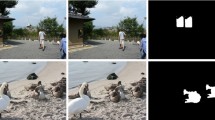Abstract
With the advent of the powerful editing software and sophisticated digital cameras, it is now possible to manipulate images. Copy-move is one of the most common methods for image manipulation. Several methods have been proposed to detect and locate the tampered regions, while many methods failed when the copied region undergone some geometric transformations before being pasted, because of the de-synchronization in the searching procedure. This paper presents an efficient technique for detecting the copy-move forgery under geometric transforms. Firstly, the forged image is divided into overlapping circular blocks, and Polar Complex Exponential Transform (PCET) is employed to each block to extract the invariant features, thus, the PCET kernels represent each block. Secondly, the Approximate Nearest Neighbor (ANN) Searching Problem is used for identifying the potential similar blocks by means of locality sensitive hashing (LSH). In order to make the algorithm more robust, morphological operations are applied to remove the wrong similar blocks. Experimental results show that our proposed technique is robust to geometric transformations with low computational complexity.









Similar content being viewed by others
References
Amerini I, Ballan L, Caldelli R, Del Bimbo A, Serra G (2011) A sift-based forensic method for copyCmove attack detection and transformation recovery. IEEE Trans Inf Forensic Secur 6(3):1099–1110
Bayram S, Sencar HT, Memon N (2009) An efficient and robust method for detecting copy-move forgery. In: Acoustics, Speech and Signal Processing, 2009. ICASSP 2009. IEEE International Conference on (pp 1053-1056). IEEE
Christlein V, Riess C, Angelopoulou E (2010) A Study on Features for the Detection of Copy-Move Forgeries. In: Sicherheit, vol 2010, pp 105–116
Christlein V, Riess C, Jordan J, Angelopoulou E (2012) An evaluation of popular copy-move forgery detection approaches. IEEE Trans Inf Forensic Secur 7 (6):1841–1854
Christlein V, Riess C, Jordan J, Angelopoulou E (2012) Supplemental Material to an Evaluation of Popular Copy-Move Forgery Detection Approaches Aug. 2012 [Online]. Available: http://www.arxiv.org/abs/1208.3665
Cao Y, Gao T, Fan L, Yang Q (2012) A robust detection algorithm for copy-move forgery in digital images. Forensic Sci Int 214(1):33–43
Datar M, Immorlica N, Indyk P, Mirrokni VS (2004) Locality-sensitive hashing scheme based on p-stable distributions. In: Proceedings of the twentieth annual symposium on Computational geometry (pp 253-262). ACM
Fridrich AJ, Soukal BD, Lukas AJ (2003) Detection of copy-move forgery in digital images. In: Proceedings of Digital Forensic Research Workshop
Huang Y, Lu W, Sun W, Long D (2011) Improved DCT-based detection of copy-move forgery in images. Forensic Sci Int 206(1):178–184
Indyk P, Motwani R (1998) Approximate nearest neighbors: towards removing the curse of dimensionality. In: Proceedings of the thirtieth annual ACM symposium on Theory of computing. ACM, pp 604–613
Jaberi M, Bebis G, Hussain M, Muhammad G (2014) Accurate and robust localization of duplicated region in copyCmove image forgery. Mach Vis Appl 25(2):451–475
Li Y (2013) Image copy-move forgery detection based on polar cosine transform and approximate nearest neighbor searching. Forensic Sci Int 224(1):59–67
Li L, Li S, Zhu H, Wu X (2014) Detecting copy-move forgery under affine transforms for image forensics. Comput Electr Eng 40(6):1951–1962
Li L, Li S, Zhu H, Chu SC, Roddick JF, Pan JS (2013) An efficient scheme for detecting copy-move forged images by local binary patterns. J Inf Hiding Multimed Signal Process 4(1):46–56
Mahalakshmi SD, Vijayalakshmi K, Priyadharsini S (2012) Digital image forgery detection and estimation by exploring basic image manipulations. Digit Investig 8(3):215–225
Nathalie Diane WN, Xingming S, Moise FK (2014) A Survey of Partition-Based Techniques for Copy-Move Forgery Detection. The Scientific World Journal
Popescu AC, Farid H (2004) Exposing digital forgeries by detecting duplicated image regions. Department Computer Science, Dartmouth College, Technology Report TR2004-515. Available: www.cs.dartmouth.edu/farid/publications/tr04.htm
Powers DM (2011) Evaluation: from precision, recall and F-measure to ROC, informedness, markedness and correlation. J Mach Learn Technol 2(1):37–C63
Redi JA, Taktak W, Dugelay JL (2011) Digital image forensics: a booklet for beginners. Multimed Tools Appl 51(1):133–162
Ryu SJ, Kirchner M, Lee MJ, Lee H. K (2013) Rotation invariant localization of duplicated image regions based on zernike moments. IEEE Trans Inf Forensic Secur 8(8):1355–1370
Yap PT, Jiang X, Kot AC (2010) Two-dimensional polar harmonic transforms for invariant image representation. IEEE Trans Pattern Anal Mach Intell 32(7):1259–1270
Yu L, Han Q, Niu X (2014) Feature point-based copy-move forgery detection: covering the non-textured areas. Multimed Tools Appl:1–18
Acknowledgements
The authors would like to thank Dr.Liyang Yu, Dr.Xianyan Wu and all anonymous reviewers for their valuable advices and insightful comments to improve the quality of this work. Additionally, This work is supported by the National Natural Science Foundation of China (Grant Number: 61471141, 61301099, 61361166006 ), the Fundamental Research Funds for the Central Universities (Grant Number: HIT. KISTP. 201416, HIT. KISTP. 201414) and Higher Education Commission of Egypt.
Author information
Authors and Affiliations
Corresponding author
Rights and permissions
About this article
Cite this article
Emam, M., Han, Q. & Niu, X. PCET based copy-move forgery detection in images under geometric transforms. Multimed Tools Appl 75, 11513–11527 (2016). https://doi.org/10.1007/s11042-015-2872-2
Received:
Revised:
Accepted:
Published:
Issue Date:
DOI: https://doi.org/10.1007/s11042-015-2872-2




